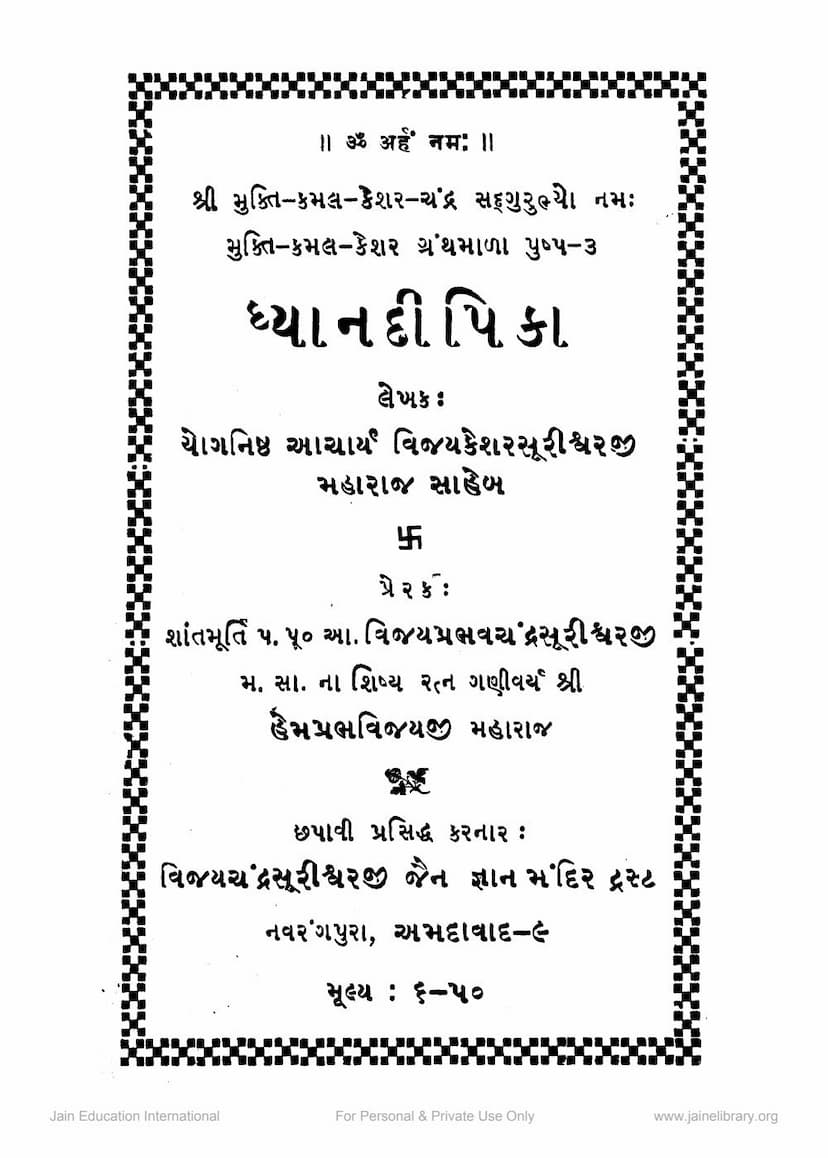Dhyandipika
Added to library: September 1, 2025

Summary
This document is a summary of the Jain text "Dhyan Deepika" (The Lamp of Meditation) authored by Muni Hemprabhvijay, published by Vijaychandrasuri Jain Gyanmandir. The book is presented as a collection of useful teachings on meditation, compiled from various sources for the benefit of seekers of spiritual advancement.
Here's a breakdown of the key aspects of the text as presented in the provided pages:
1. Genesis and Authorship:
- Primary Author: Muni Hemprabhvijay, a disciple of Acharya Vijayprabhavchandra Surishwarji Maharaj.
- Inspiration/Source Material: The text is largely a compilation from various Jain scriptures and works, primarily drawing from "Dhyan Shatak" (a hundred verses on meditation) by Acharya Haribhadra Suri, and also from works by Acharya Hemchandracharya and Acharya Shubhamchandra. The preface suggests that Upadhyay Sakalchandraji, a disciple of Danvijayji and student of Heeravijayji Suri, was the original composer of the Sanskrit text that "Dhyan Deepika" is based on. The composition is estimated to be around Vikram Samvat 1621.
- Compilation and Arrangement: The author, Muni Hemprabhvijay, is credited with compiling and arranging the material, while Acharya Vijaykesarsurishwarji Maharaj provided a commentary with spiritual insights. The preface explicitly states that Upadhyay Sakalchandraji is considered the author of the original "Dhyan Deepika," which was written in Sanskrit and contained approximately 45 Gathas and verses in Magadhi and Sanskrit.
2. Purpose and Audience:
- Purpose: To guide individuals towards meditation and self-realization, leading to the destruction of karma and the attainment of liberation (moksha). The book aims to provide peace and solace to those suffering from worldly unrest.
- Audience: The text is intended for those who are devoted to meditation, seek self-improvement, wish to overcome negative tendencies, and have renounced worldly life or are deeply inclined towards spiritual practices. It is stated that even those who are not yet fully qualified can find many useful practices within the book to help them become qualified.
3. Structure and Content:
The book is divided into nine chapters, covering various aspects of meditation and spiritual development:
- Chapter 1: Mangalacharan, Subject, and Instructions: Covers introductory invocations, the subject matter, and initial guidance for meditation. It also includes a section on "What is beneficial for the soul?"
- Chapter 2: Gyan Bhavana (Meditation on Knowledge): Discusses the importance of knowledge in spiritual practice.
- Chapter 3: Anityaadi Bhavana (Meditations on Impermanence, etc.): Details twelve types of reflections, including impermanence, non-refuge, worldly suffering, impurity, etc., and the need for spiritual discipline and perseverance.
- Chapter 4: Hit Shiksha (Beneficial Teachings): Offers practical advice on meditation, emphasizing its role as a means to liberation, the futility of worldly pursuits without self-realization, and addressing questions about who can meditate and the nature of meditation for different individuals (including potentially counterfeit practitioners).
- Chapter 5: Art Dhyana (Sorrowful Meditation): Describes the characteristics of sorrowful meditation, categorized into four types, likely related to afflictions and attachments.
- Chapter 6: Raudra Dhyana (Fierce Meditation): Expounds on the nature of fierce meditation, detailing its various forms and characteristics, often linked to violence and anger.
- Chapter 7: Dharma Dhyana (Righteous Meditation): Elaborates on righteous meditation, including a detailed discussion of the eight limbs of yoga (Yama, Niyama, Asana, Pranayama, Pratyahara, Dharana, Dhyana, Samadhi) and their associated ethical principles.
- Chapter 8: Dhyana Alamban (Objects of Meditation): Explains the various subjects and goals of meditation, including self-realization, different types of meditation (Pindastha, Padmastha, Rupastha, Rupateet), and the process of becoming one with the object of meditation.
- Chapter 9: Shukla Dhyana (Pure Meditation): Delves into the nature of pure meditation, its stages, and its ultimate aim.
4. Key Themes and Concepts:
- The Nature of Reality: The text emphasizes the impermanent nature of worldly things, including wealth, relationships, the body, and even divine states like Indra's power or youth.
- The Soul's True Nature: It stresses that the soul is distinct from the body and the material world, possessing inherent purity, knowledge, and bliss.
- Karma and Liberation: A significant focus is placed on the role of karma in the cycle of birth and death and how meditation and righteous conduct lead to the shedding of karma and liberation.
- The Importance of Bhavanas (Reflections): The text outlines various "bhavanas" or reflective meditations (like impermanence, non-refuge, worldly suffering, impurity) as crucial for purifying the mind and preparing it for deeper meditation.
- The Fourfold Path of Meditation: The book details different types of meditation: Art Dhyana (Sorrowful), Raudra Dhyana (Fierce), Dharma Dhyana (Righteous), and Shukla Dhyana (Pure).
- Mind Control: A central theme is the necessity of controlling the mind, turning it away from worldly distractions and focusing it on the true self or divine principles.
- The Role of a Guru: While not explicitly detailed in the provided pages, the compilation from various masters suggests the importance of spiritual guidance.
- Ethical Living: The eight limbs of Yoga are mentioned, highlighting the integration of ethical conduct with meditative practices.
5. Publication Details:
- Publisher: Vijaychandrasuri Jain Gyanmandir Trust, Navrangpura, Ahmedabad.
- Edition: Third edition, published in Vikram Samvat 2032 (1976 CE).
- Praise and Support: The publication mentions donations received from various individuals and sanghas, indicating community support for this spiritual endeavor. Special mention is made of Shrimati Sharda Ben Kirtikarbhai Shah and Shri Kirtikar Chunnilal Shah for their significant contributions and passion for publishing spiritual literature.
In essence, "Dhyan Deepika" is a comprehensive guide to meditation within the Jain tradition, emphasizing the purification of the mind through various reflections, ethical practices, and focused concentration to achieve spiritual liberation. It aims to illuminate the path of meditation for sincere seekers by drawing from the wisdom of revered Jain acharyas.